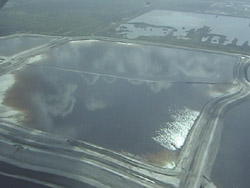September 08, 2004
60 million gallons of radioactive toxic sludge released into Tampa Bay
Update - Protest Thursday to draw awareness to Cargill's negligence - see comments for details.
So far, at least officially, 60 million gallons of radioactive, highly acidic waste water has spilled into Tampa Bay.
A month ago, Cargill Crop Nutrition received an award for its environmental stewardship.On Tuesday, company representatives stood watch as government officials surveyed the environmental damage created when the fertilizer manufacturer dumped 60-million gallons of acidic water into a creek leading to Hillsborough Bay.
Water in the bay tested normal on Tuesday, but officials from the National Oceanic and Atmospheric Administration said they saw a handful of dead stingrays, mullet and snook floating along a 75-foot stretch of shore.
Local crabbers reported pulling up traps with dead animals, and plants suffered damage.
"We did see some vegetation burns out there today, so it's evident that what went through there was unkind to the vegetation," said Rick Garrity, director of the Hillsborough County Environmental Protection Commission.
I’ve got to note that the “award” was presented to the company for doing exactly what it is required by law to do. This is like giving drivers awards for obeying basic traffic laws.
...the Alafia River Basin Board honored Cargill for its restoration of 4 miles of company-owned coastline, a requirement of Cargill's operating permits.
Back to the spill: Cargill fertilizer was warned twice by the state in the last month to get their act together. First, the DEP complained that the berm which was eventually breached was too thin. Then, Cargill was warned that the water level in this pond was way too high. They were told to pump excess water into an old stack across the street.
The company says it was taking steps to remedy these problems, but they obviously did not do enough. And even after being warned that the pond was dangerously full, they failed to ensure that they had an adequate supply of caustic soda to neutralize the acid in the event of a spill.
Everyone is talking about the acid levels, which will probably result in killing everything in the creek and a swath of bay that receives runoff. Everything will probably die. Plants, fish, crabs, the whole ecosystem. Except for algae. Algae will bloom and worsen the situation.
 |
The big open secret about this spill is the radiation and toxic materials. The waste pond from which the water escaped sits atop a highly radioactive stack of gypsum.
It is sort of a misnomer, however, to call these stacks "gypsum" stacks. Indeed, if the stacks were simply gypsum, they probably wouldn't exist, as gypsum can be readily sold for various purposes (e.g. as a building material). What can't be readily sold, however, is radioactive gypsum, which is about the only type of gypsum the phosphate industry has to offer.The source of the gypsum's radioactivity is the presence of uranium, and uranium's various decay products (i.e. radium), in raw, phosphate ore. As noted by the Sarasota Herald Tribune
"there is a natural and unavoidable connection between phosphate mining and radioactive material. It is because phosphate and uranium were laid down at the same time and in the same place by the same geological processes millions of years ago. They go together. Mine phosphate, you get uranium."While uranium, and its decay-products, naturally occur in phosphate ore, their concentrations in the gypsum waste, after the extraction of soluble phosphate, are up to 60 times greater.
The gypsum has therefore been classified as a "Naturally Occurring Radioactive Material", or NORM waste, although some, including the EPA, have questioned whether this classification understates the problem. According to the Tampa Tribune, the gypsum "is among the most concentrated radioactive waste that comes from natural materials."
It is so concentrated, in fact, that "it can't be dumped at the one landfill in the country licensed to take only NORM waste."
Thus, according to US News & World Report, the EPA is currently "weighing whether to classify the gypsum stacks as hazardous waste under federal statutes, which would force the industry to provide strict safeguards" (to nearly 1 billion tons of waste).
One of EPA's main concerns with gypsum stacks centers around the fact that radium-226 breaks down into radon gas. When radon gas is formed, it can become airborne, leading to potentially elevated exposures downwind of the stacks. Such airborne exposures are of particular concern to areas like Progress Village, Florida, where "a new gypsum stack is rising a few hundred yards from a grade school."
According to US News & World Report, there is evidence to suggest that cancer rates downwind of the stacks may be elevated. A 1995 article in the magazine stated:
"Some epidemiological studies suggest that lung cancer rates among nonsmoking men in the phosphate region are up to twice as high as the state average. Acute leukemia rates among adults are also double the average. An industry-sponsored study of male phosphate workers, however, found lung cancer rates no higher than the state average. There is no proof that mine wastes cause cancer, but the evidence is worrisome."
No need to worry about the health of Progress Village: most of its citizens are poor and black, so we can safely ignore the looming 25 story pile of (figuratively) glowing rocks that is the dominant feature of the landscape.
But I digress. As well as the various decay-products of uranium, the waste water contains fluoride, arsenic, cadmium, chromium, lead, and mercury, a toxic stew to rival the worst in industrial waste. This is all settling on the bottom of Tampa Bay right now.
So, even if Cargill had started with enough caustic soda to “treat” all of the spilled water to bring up the pH levels, all of the toxins still would have escaped into the bay.
Gypsum stacks and ponds are becoming very problematic. Often, having extracted every penny of viable profit from a site, having irrevocably scarred huge tracts of land by scraping away 10 to 20 feet of topsoil, having built huge mountains of radioactive waste, companies walk away. They go bankrupt or simply stop maintaining their sites and leave the state with billions of dollars in cleanup costs.
 |
One spill, in 1997, from a now-defunct gypsum stack in Florida, "killed more than a million fish.""Strike the Alafia River off your list of fishing spots," wrote one journalist after the spill. "It's gone, dead as a sewer pipe, killed by the carelessness of yet another phosphate company."
Today, the same gypsum stack which caused this particular spill, is considered by Florida's Department of Environmental Protection to be "the most serious pollution threat in the state." That's because tropical rains over the past couple of years have brought the wastewater to the edge of the stack's walls.
As noted by the Tampa Tribune, "The gypsum mound is near capacity, and a wet spring or a tropical storm could cause a catastrophic spill."
To prevent such a spill, which was all but inevitable, the EPA recently agreed to let Florida pursue "Option Z": To load 500-600 million gallons of the wastewater onto barges and dump it directly into the Gulf of Mexico.
The dumping of the wastewater into the Gulf represents the latest in a series of high-profile embarrasments for Florida's phosphate industry; one of the most dramatic of which happened on June 15, 1994.
On that day, a massive, 15-story sinkhole appeared in the middle of an 80 million ton gypsum stack. The hole was so big that, according to US News & World Report, it
"could be as big as 2 million cubic feet, enough to swallow 400 railroad boxcars. Local wags call it Disney World's newest attraction -- 'Journey to the Center of the Earth.'"
But, as US News noted,
"there's nothing amusing about it. The cave-in dumped 4 million to 6 million cubic feet of toxic and radioactive gypsum and waste water into the Floridan aquifer, which provides 90 percent of the state's drinking water."
And so it goes.
As summarized by the Tampa Tribune:
"It's not like you can padlock the doors and walk away. The complexities of keeping a phosphate processing plant operating are becoming clear to government regulators now overseeing two of them. Ponds full of 1.5 billion gallons of acid and three mountains of radioactive waste mean you just can't shut off the machinery and turn out the lights. The state could be stuck with the plants for years. And taxpayers would be stuck with the tab."
Posted by Norwood at September 8, 2004 09:53 AM
Thanks for the terrifying and informative post. Is this story getting through the hurricane in the local media??? Someone ought to take a gallon of polluted water to a Bush event and pour it on the floor - just to see if we can get Homeland Security to declare it a weapon.
Dangerous business. Keep pushing this story please.
Posted by: Screwy Hoolie at September 8, 2004 10:59 AMI saw your post on DailyKos.com and on your own blog, and wanted to pass this along in hopes that you would help promote the event.
___________________________________________
For all Concerned Citizens
Protest
the
Recent Acidic, radioactive
water spill into bay
at the
Cargill Phosphate Plant
8813 US Highway 41
(Tamiami Trail)
Riverview, FL
11AM -Thursday Sept. 9th
*Protesters*
please bring your own signs - be artistic
&
meet and Park at
Williams Park
(see Map & directions)
--------------------------------------------------------------------------------------------
For more information and carpooling please at
or
///////////////////////////////////////////////////////////////////////////////////////////////////////////////////////////////////
Please Click on below
Map of Williams Park meeting place for Protest by 11 AM Sharp
Directions from St Petersburg,FL to Cargill Fertilizer Plant, Riverside,FL
\\\\\\\\\\\\\\\\\\\\\\\\\\\\\\\\\\\\\\\\\\\\\\\\\\\\\\\\\\\\\\\\\\\\\\\\\\\\\\\\\\\\\\\\\\\\\\\\\\\\\\\\\\\\\\\\\\\\\\\\\\\\\\\\\\\\\\\\\\\\\\\\\\\\\\\\\\\\\\\\\\\\\\\
Newspaper Articles
http://www.sptimes.com/2004/09/06/Hillsborough/Acidic__radioactive_w.shtml
http://www.sun-sentinel.com/news/local/florida/sfl-905spill,0,5970865.story?coll=sfla-news-florida
http://www.miami.com/mld/miamiherald/news/state/9591960.htm
http://news.tbo.com/news/MGB5JW6GTYD.html
Peace, commerce and honest friendship with all nations;
entangling alliances with none. - Thomas Jefferson
www.stpeteforpeace.org www.bringbackccc.org
